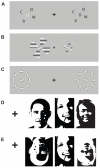Visual crowding: a fundamental limit on conscious perception and object recognition
- PMID: 21420894
- PMCID: PMC3070834
- DOI: 10.1016/j.tics.2011.02.005
Visual crowding: a fundamental limit on conscious perception and object recognition
Abstract
Crowding, the inability to recognize objects in clutter, sets a fundamental limit on conscious visual perception and object recognition throughout most of the visual field. Despite how widespread and essential it is to object recognition, reading and visually guided action, a solid operational definition of what crowding is has only recently become clear. The goal of this review is to provide a broad-based synthesis of the most recent findings in this area, to define what crowding is and is not, and to set the stage for future work that will extend our understanding of crowding well beyond low-level vision. Here we define six diagnostic criteria for what counts as crowding, and further describe factors that both escape and break crowding. All of these lead to the conclusion that crowding occurs at multiple stages in the visual hierarchy.
Copyright © 2011 Elsevier Ltd. All rights reserved.
Figures





References
-
- Levi DM, et al. Suppressive and facilitatory spatial interactions in peripheral vision: peripheral crowding is neither size invariant nor simple contrast masking. J Vis. 2002;2:167–177. - PubMed
-
- Levi DM, et al. Suppressive and facilitatory spatial interactions in amblyopic vision. Vision Res. 2002;42:1379–1394. - PubMed
-
- Pelli DG, et al. Crowding is unlike ordinary masking: distinguishing feature integration from detection. J Vis. 2004;4:1136–1169. - PubMed
Publication types
MeSH terms
Grants and funding
LinkOut - more resources
Full Text Sources

